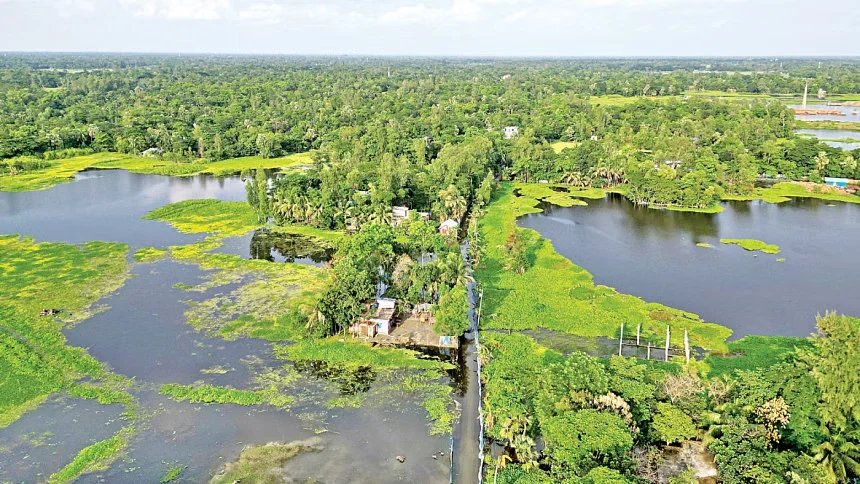Half of Noakhali still reeling from flood
Share on:

Clogging of canals leads to prolonged inundation
Sixty-year-old Kofil Uddin watched helplessly as floodwater crept into his home at Bhabani Jibanpur village in Noakhali's Begumganj upazila on August 10. More than a month has passed, but the house is still under knee-deep water.
Floods devastated much of Chattogram and Sylhet divisions in Bangladesh last month following a sudden surge of water from the upstream in India, coupled with heavy rainfall. Although floodwater has receded in most areas, more than half of Noakhali remains under water.
Kofil and other locals, along with officials and experts, have blamed the clogging of canals by encroachers for the prolonged floods in the district, which one of the elderly residents called unprecedented in living memory.
Md Abdullah, 70, another resident of Bhabani Jibanpur village, said he had never seen such destruction by floods in his life.
"We've been marooned by flood for one month," he said and complained that he received no relief when he stayed in the Chhoyani Girls High School for 15 days during the flood.
After the floods affected at least 21 lakh residents in the district last month, 60,000-70,000 people are still living in shelters, said Noakhali Deputy Commissioner Dewan Mahabubur Rahman.
As long as the educational institutions have been turned into flood shelters, the authorities are unable to resume academic activities and they have requested the local administration to move the people to other places.
The canals in the district are also filled with garbage, while fish farms and unplanned sluice gates, regulators or cross dams have blocked the natural flow of water into the Meghna river.
Besides elongated suffering of the locals by the flooding, the effects of climate change have fuelled further concerns about the possibility of saline water from the sea entering the district and getting stranded in the low-lyng areas, which will impact farming and source of fresh water.
Kofil said rain and flood water of Begumganj upazila flows through Gabua canal via Lakshmipur into the Meghna river. A sluice gate was constructed three kilometres upstream from his village around 10 years ago. "This has been an obstacle to the natural drainage system. As a result, the flood water is not rereading significantly."
Apart from Hatia, the remaining eight upazilas of Noakhali were hit by floods. Around 60 percent of these upazilas are still under water. The most affected upazilas are Begumganj, Senbagh, Chatkhil, Sonaimuri, and Sadar.
Md Salim of Baro Sardar Para of Senbagh upazila said the roads and homes of the village are still under water with all the canals in the area blocked, filled up with garbage or encroached on.
"We are requesting the government to investigate the matter and clear the canals. We do not seek any other assistance," he said.
Munshi Amir Faisal, executive engineer of the Water Development Board in Noakhali, said only 2 cm of floodwater receded in the district from 6:00am to 6:00pm last Wednesday.
The water from Chatkhil, Sonaimuri, Begumganj, and Sadar upazilas falls into the Meghna river through the Rahmatkhali canal of Lakshmipur district through the Rahmatkhali regulator, according to him.
"However, the Lakshmipur part of the Rahmatkhali canal has not been excavated for a long time. Due to this, floodwater is not receding quickly. Moreover, there is a pile of garbage in every canal."
A cross dam was constructed in an area of 16 km up from Mannan Nagar to Atakpalia of sadar upazila in 1964 to save 71,000 hectares of land in Subarnachar upazila from river erosion.
But due to the construction of the dam, Subarnachar has become a higher ground than sadar upazila, obstructing the natural drainage system, Faisal said.
Abdul Awal, executive director of Noakhali Rural Development Society who is vocal about the environmental degradation, said hundreds of big ponds dug in Noakhali earlier for holding rainwater have been filled up for construction.
Noakhali and Lakshmipur had numerous small and big canals, including Noakhal, Begumganj's Wabda, and Bhulua, which were interconnected, according to him.
"Now the canals have been encroached on for fish farming. So, the path for floodwater to the sea is now blocked," Awal said.
"Today's Maijdee town itself was once a big canal named Chhagalmara. Noakhal was next to Chhagalmara. Water used to go to Lakshmipur through these canals. Noakhali had a natural drainage system in the past. Now all canals are blocked by illegal structures, plastic garbage, or other objects," he said.
He suggested using satellite imagery to find out the path of the natural flow of water.
"It is very important to identify the obstacles and then remove them on a priority basis. The sea levels continue to rise. In that case, the saline water of the sea can enter the land and stay for a long time. To end this crisis, the government needs to have a mega plan," Awal said.

